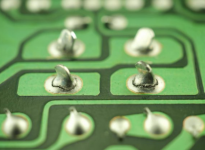TwistLock
Senior Member
- Location
- California
- Occupation
- Electrician
.... but knowing that Wago makes the same / similar product puts my mind at ease that these aren't some one-off's in an evolving model line - Thanks.
Amazon is swimming with clones of the Wago design: many of which are "UL listed" with the quotes being intentional.The case design of these doesn’t quite match the Wago brand
Ok, I'm an engineer: with experience in lifecycle failure analysis of PC boards.Picked up a clients EVbox EVSE today (Benz version). The line terminals are push in. Seems a little sketchy for continuous use equip .. no?
There’s no wire range listed just says use 4awg.
I spoke with EVbox’s weak sauce support and they said stranded is fine to insert without ferrule, though they have no documentation about using smaller gauges than 4awg, other than to say “…the engineer said it should be fine”.

Is that due to (a) mechanical effects (solder trying to restrain a heavy wire against vibration and so on) (b) thermal effects (from large magnitude current cycling) (c) other (d) one or more of the above?What happens over time with heavy wires and PC board connectors is the solder starts to crack: at the PC board.
Is that due to (a) mechanical effects (solder trying to restrain a heavy wire against vibration and so on) (b) thermal effects (from large magnitude current cycling) (c) other (d) one or more of the above?
Definitely.This speaks to training the workforce, and hiring highly skilled electricians as inspectors.
Spring loaded terminals are what the renewable energy industry is doing. It’s cheap and easy, not necessarily safe and durable. In one of my very first inspections of these terminals, in an inverter, I found 100% of the wires installed had several strands folded back, not inserted into the terminal. You can’t see them without pulling the wires out for a physical inspection. I started requiring ferrules immediately, and, recently, the inverter manufacturer has started recommending them as well. It’s a slow process so they don’t yet require them, but just a few more fires, and they will get the idea. Been trying to get them to use standard touch safe fuse holders, with screw terminals, but they are just interested in the cheapest way possible. With as many failures as we see in solar/renewables, it would be great if we could stop building everything to the bare minimum standards, and try actually hardening the grid. This speaks to training the workforce, and hiring highly skilled electricians as inspectors.
"Requiring" because you're the specifier? Or requiring as the inspector for the AHJ? If the AHJ has only adopted the NEC, I don't see how you could require ferrules because one job had an incompetent installer misuse the product.Spring loaded terminals are what the renewable energy industry is doing. It’s cheap and easy, not necessarily safe and durable. In one of my very first inspections of these terminals, in an inverter, I found 100% of the wires installed had several strands folded back, not inserted into the terminal. You can’t see them without pulling the wires out for a physical inspection. I started requiring ferrules immediately
This is 100% on the installers, can't blame a product for shoddy work. I have PTSD from some of the stuff I have seen solar installers do....Spring loaded terminals are what the renewable energy industry is doing. It’s cheap and easy, not necessarily safe and durable. In one of my very first inspections of these terminals, in an inverter, I found 100% of the wires installed had several strands folded back, not inserted into the terminal. You can’t see them without pulling the wires out for a physical inspection. I started requiring ferrules immediately, and, recently, the inverter manufacturer has started recommending them as well. It’s a slow process so they don’t yet require them, but just a few more fires, and they will get the idea. Been trying to get them to use standard touch safe fuse holders, with screw terminals, but they are just interested in the cheapest way possible. With as many failures as we see in solar/renewables, it would be great if we could stop building everything to the bare minimum standards, and try actually hardening the grid. This speaks to training the workforce, and hiring highly skilled electricians as inspectors.
Let's be fair, I can say the same for ECs.This is 100% on the installers, can't blame a product for shoddy work. I have PTSD from some of the stuff I have seen solar installers do....
